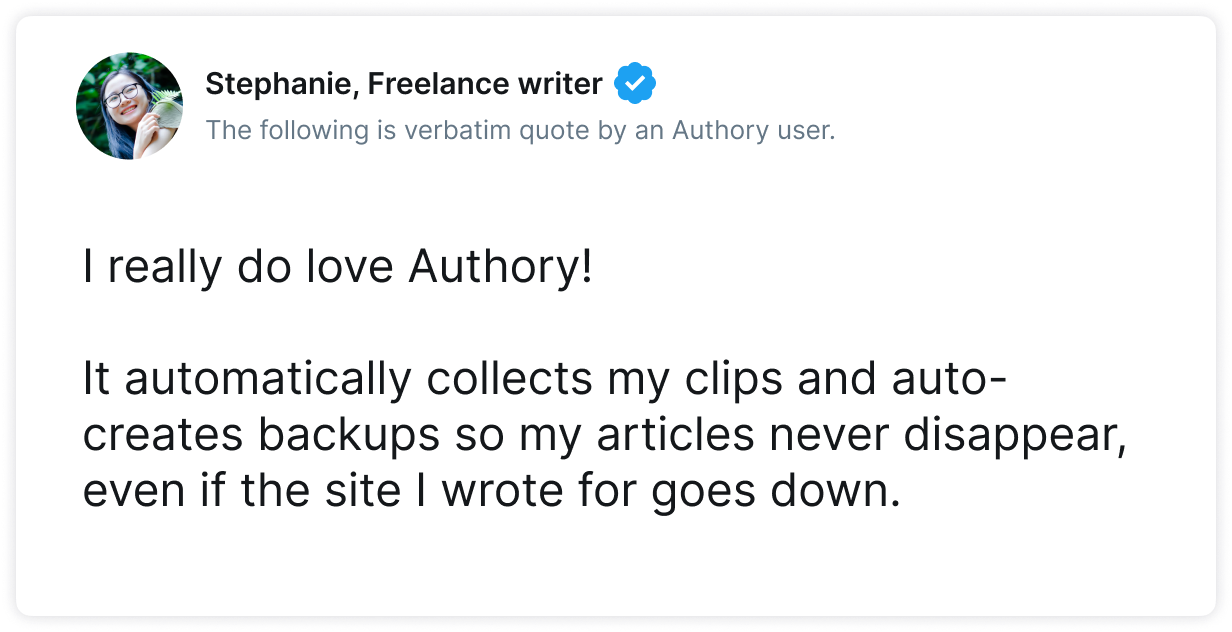Want to learn how to write pitches editors will actually read — and commission? Join me September 18 for an in-depth pitching workshop that will cover everything from structure and what to include in a pitch to how much pre-reporting you should do and how to find editors to pitch, and much, much more. Click here to register. (All registrants will receive a full playback of the event, and paid subscribers get 50% off tickets.)
Hello team! I hope you all had a lovely Labor Day and are gliding smoothly back into real life this week.
A while back I talked a little about pre-reporting, but today let’s elaborate on it and look at what it really means to do the “right” amount of pre-reporting for a pitch. (As always, remember there are no “right” answers to any question in freelancing or writing in general, so these are just guidelines and suggestions!)
In that newsletter, I wrote,
As a rule of thumb for pitching, I always say that you should do the absolute minimum amount of pre-reporting required for you to understand the shape, complexities, and nuances of your story, and be able to explain them in the pitch to the editor. Why do more work than is necessary, especially when you have no idea whether it’ll pay off?
Frankly, we could stop right here — that’s pretty much the gist of it. Stop doing unnecessary unpaid labor! (I’m just gonna plaster that sentence in every newsletter at some point.)
Kidding aside, there’s a lot of variation and many tricky questions that come into play when you’re pre-reporting a story in order to write a pitch for it, and no real “correct” answer. So let’s dive in.
Sponsored: All your clips, all in one place
Stop losing track of your articles scattered across the internet.
Authory automatically gathers everything you’ve published in one place, making it easy to search, find, and share your work.
Need to show a potential client your articles matching their requirements best? They’re just a click away.
Thousands of writers are streamlining their careers with a portfolio that’s organized, discoverable, and ready to impress. Authory really makes it that simple.
First things first: What’s the difference between knowing what my story is and being able to explain it to someone else?
So glad you asked!
Regulars to my workshops will recognize this phrase; I use it quite often, since it really applies to every step of the pre-reporting process.
What I mean by it is this: The best way to fully comprehend and understand a subject is to teach it to someone else (it’s called the Protégé Effect). So while you may think you fully get everything that’s going on with your story — the themes, big-picture ideas, narrative, driving forces, characters, ideal structure, and so on — do you have a strong enough grasp on all of that to explain it to someone coming in completely blind to the topic? In most cases, probably not!
That’s totally fine and normal for every pitch, but it is an issue you need to resolve before sending it along. There are two super simple and helpful ways to practice this:
Try to explain everything about your story to a friend in your freelance network. If you can talk for, say, five straight, uninterrupted minutes about your story and explain everything an outsider would want to know at this point in the process, you’re probably in good shape. (And yes, you can do this in front of a mirror if you’d prefer — I literally have done that.)
Put on your editor hat and try to anticipate what questions an editor would ask you after reading your pitch. You can’t predict what they’ll really ask, of course, but know the context and surrounding information about your story that doesn’t necessarily fit in the pitch itself, but that an editor could potentially ask about.
Okay, so just level with me now: How much pre-reporting do I really need to do?
As with all things freelance, the answer is: it depends. So let’s break it down into a few general categories. And again, just to be clear: These are not rules, they are general guidelines, and they do not apply to every story every time.
Say you’re pitching something in the range of 800 to 1,200 words — a range I think most stories should shoot for in a cold pitch, unless there’s a reason not to. (I like this range because it’s not so long and overwhelming the editor will rule it out; there’s a ton of wiggle room to give you some freedom in putting it together; it’s a very common range for many publications; and it often can be negotiated in either direction.)
For something in this range that isn’t a deep dive, an in-depth explanatory piece, or a source-dependent feature, I would say the baseline is to read absolutely everything published in the recent past around your idea that you can get your hands on. This will help you build up your general knowledge around the topic, and it’ll show you what’s been done before so you can avoid going those routes, which only helps your chances of selling your idea. (Be unique! Come with something fresh and original!)
Beyond that, start scoping out the types of sources you’ll want to include in your story. At this point, you don’t necessarily have to have reached out to specific people, but you should have a good sense of the type of expert you want to talk with, or the type of data you’ll cite. Below is some example pitch language I like to point people to, which I’ve cobbled together from a story about salary negotiations (steal this format and phrasing if it works for you!):
I’m pitching a 1,200-word reported service story about salary negotiations and how to stop being scared of them — and how to get better at them. I plan to talk to an economics professor, an executive of an advocacy group, a law professor, and an author who’s an expert on the topic, and I’ll cite data and advice from the American Association of University Women and the National Labor Relations Board.
At this point in the process, I have no clue who I’m actually going to reach out to; I just know I want those types of people in the story. (Ditto for the data.)
Sure, but what about pre-interviews? Do I need to do those?
Maybe! It depends!
If you’re writing in an area or on a topic you’re not terribly familiar with, sometimes a pre-interview can be really helpful to get you in the right mindset and help you sharpen up your thinking around the story. Sometimes you go into a story with very limited knowledge, so a pre-interview can establish a foundation for you before you formally reach out to sources. (Plus, it gives you the chance to ask all the dumb questions you have before talking to the experts — though, another rule of thumb, you should still be asking those dumb questions any time you have them, with any source. Don’t be scared of sounding ignorant or uninformed, that’s the whole reason you’re talking to the experts!)
Typically these shouldn’t last more than 10 or 15 minutes for most stories. Go in with a list of things you want to talk about, but give the source enough space and time to tell you what you should be asking and thinking about. Remember to include these three magic questions at some point in your pre-interview (and every interview thereafter).
As far as setting up a pre-interview, just send an email and say something like this:
Hi, I’m researching a story around X topic, and I’m wondering if you might be up for an off-the-record, 10-minute phone chat to help me shape my thinking around this topic.”
Keep it simple, and keep the stakes low.
What else?
Just to close the loop here: If you are pitching a deep dive, an in-depth explanatory piece, a source-dependent feature, or really anything you’re very unfamiliar with, pre-interviews become kind of mandatory. Again, there’s no rule for when you need to do them. Just keep in mind the guideline that always applies: Know your story, and know how to explain it to an outsider.
Yeah, yeah, I get it already. Are there times I need to secure access to a source or sources before pitching my idea?
Yep! This one is a little more clear-cut than other situations; the rare circumstance in which “it depends” doesn’t really apply. That’s when your story cannot exist without the participation of this one source or these sources. So here are your profiles, niche topics that hinge on access to one specific person (or a few specific people), features about something or someone in which you simply can’t get the necessary information otherwise, and any other story that falls into the general category of, “I need this person or these people, otherwise I don’t have a story.”
In those situations, it’s kind of the same rule as before, but with one additional requirement: Set up the pre-interview, but tell that source or those sources that you’ll come back to them once the story is sold so you can conduct your formal, on-the-record interview. Or, for say, profiles, say you want to profile them and you want to do a pre-interview before you formally start interviewing them just to get a little background and, of course, make sure they want to participate. (Though even that isn’t always necessary.) Repeat as necessary.
Final thoughts?
Don’t do more work on pre-reporting than is absolutely necessary! Yes I will shout this from the rooftops until I retire!
Good luck out there friends!
Oh, a few other things …
If you like what you’re reading, please consider subscribing to the paid version of this newsletter. Paid subs get an extra newsletter every week, access to all past and future paid-only posts, 50% off all Zoom workshops, a guide to avoiding the 7 most common mistakes in freelancing, a must-have checklist for getting your assignments right, the exact text of a pitch I sold to The Atlantic, practical tips for diversifying your freelance income, and much more.
I offer one-on-one coaching! Is your story falling apart and you need a second eye on it? Want a seasoned perspective on a pitch you’re kicking around? Interested in talking about careers and building your freelance business? Maybe just want an edit on a story draft? I’ve got you covered! Click below to book a one-on-one coaching session to talk about pitches, story ideas and development, editing, careers, or anything else you might need help with!
Get a pitch commissioned recently? I want to see it! I’d love to feature you and your #pitchesthatsold in an upcoming series examining great pitches that resulted in stories. Let’s see ’em!






Great newsletter! I've always had questions about this topic and you cleared it right up for me.
But with some sources don't you just need to speak to them immediately to keep yourself fresh in their mind? They might go less deep or give you less or rethink it if they're vulnerable for instance if you email them in a week or more? I worry that the source will say yes then change their mind also I struggle to ask the right questions to get them to open up and give me good quotes so later on they might be more closed off.